Living and Teaching English in Korea - Habits, Customs & Curiosities
South Korea is one of the most popular destinations in the world for teaching English as a foreign language as it offers an exciting culture, beautiful natural scenery and a multitude of EFL jobs with high salaries and great benefits.
If you are unsure whether it is the right destination for you or you simply want more information before you leave, read on to find out more.
Below you will find information on how to budget for teaching English in Korea, the types of teaching jobs available, general travel tips and a variety of insights into the local culture.
|
South Korea is one of the most popular markets for teaching English as a foreign language. Thousands of teachers decide to live and work in South Korea each year, but how much money do you really need in order to make the leap?
A TEFL certificate and high school transcripts are often required as well. All your documents will need to be apostiled.
|
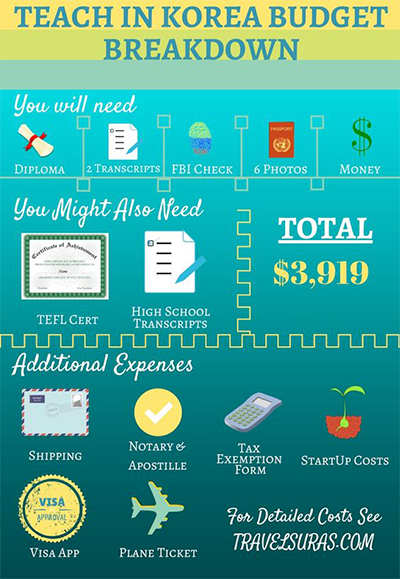 |
Consider that you will need at least a four-year degree in order to obtain a work visa in Korea. You will also need 2 university transcripts, an FBI background check, 6 photos and enough money to get you through until your first paycheck arrives.
Additional costs for your visa application and plane tickets can amount to around $4,000 USD.
|

|
Korea has suffered from a cold-war-like division since the end of World War II when the country was split in half, with the north of the country under the administration of the Soviet Union and the south administered by the US.
With over 70 years of separation, the two countries have developed big differences to one another.
While Korean is spoken in both countries, the language has changed tremendously due to the influence of technology and ‘Westernization’ in South Korea.
|
 |
The Korean War (1950–1953) left the two Koreas further separated by the Korean Demilitarized Zone (DMZ).
The most obvious differences are within the political systems with North Korea being a Communist dictatorship and South Korea having a democratically elected government.
On top of that, the life expectancy in North Korea is significantly lower with an average of 69.5 years while South Koreans live until the age of 81.37 on average.
|

|
South Korea is a very popular destination for teaching English abroad. When applying for teaching positions, keep in mind that there are two sectors for English education in the country: private language schools and public schools.
Public schools often only have one foreign teacher, while private academies have multiple. Public schools have set working hours from 8:30 a.m. to 4:30 p.m., while academies often open on weekends and start classes later in the day.
|
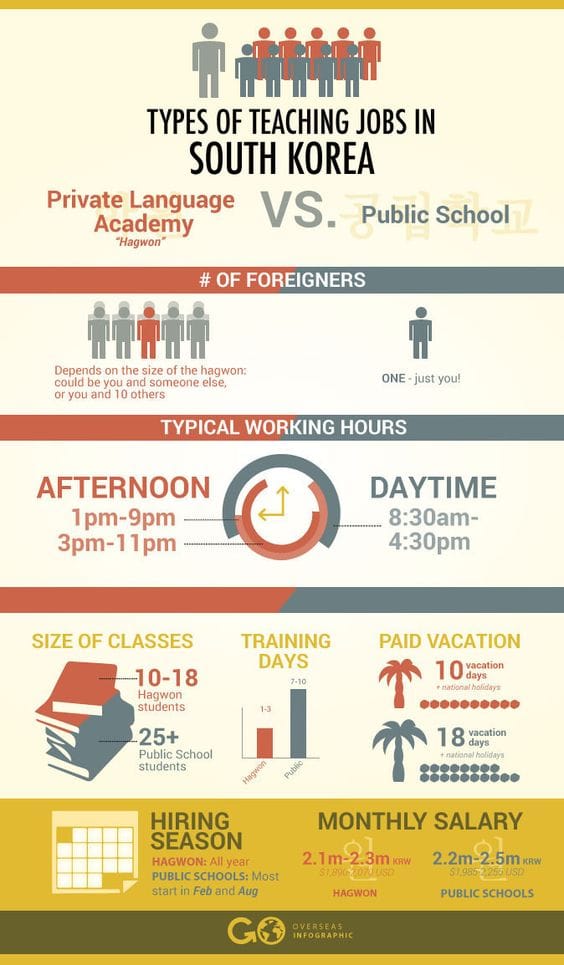 |
The two systems differ greatly in various aspects including, coworkers, working hours, class size, vacation days, salary and more.
Class sizes in private language schools are also much smaller compared to public schools. Public school teachers enjoy slightly more holidays, but the starting salaries at academies are slightly higher.
|

|
South Korea is located on the southern half of the Korean Peninsula in East Asia. It shares a border with North Korea and is surrounded by seas to the east, south, and west.
The rest of South Korea is filled with beautiful scenery, including a total of 22 national parks, countless Buddha statues and temples, and scenic beaches.
When in Korea, be sure to try kimchi, BBQ, bibimbap, Korean fried chicken and soju. Don’t forget to take your shoes off when entering Korean people’s homes and pour drinks for others.
|
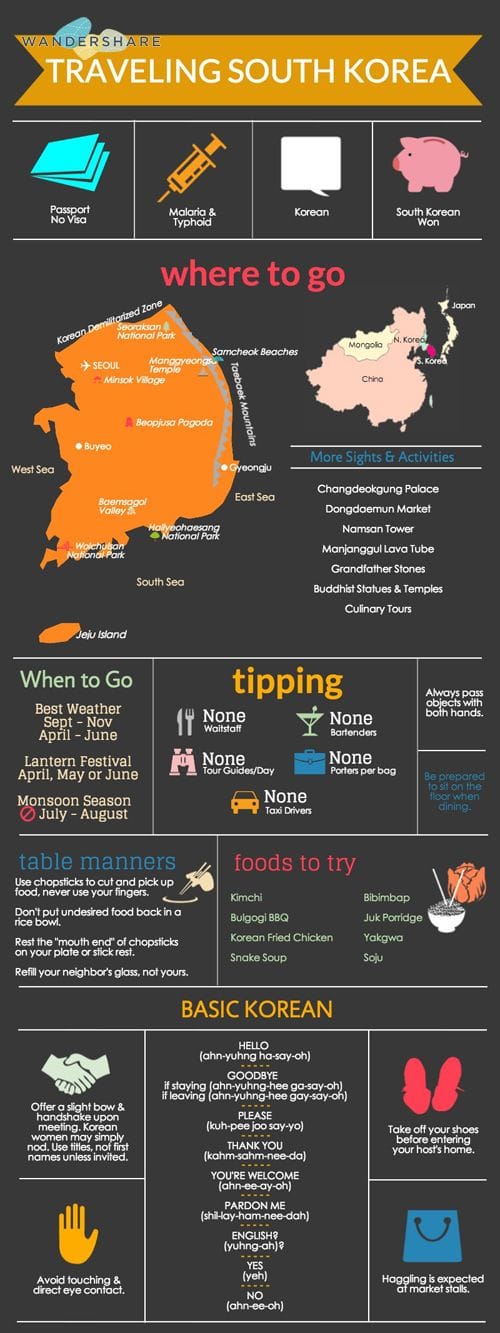 |
The largest city and capital is Seoul located in the northern part of the country. Some of the best tourist attractions in Seoul include Gyeongbokgung and Changdeokgung Palace, Dongdaemun Market, and Namsan Tower.
Generally, South Korea is a great country to explore year-round, although July and August are extremely hot and wet due to the monsoon season.
|

|
It might surprise you to hear that South Koreans consume more hard liquor per person than any other country in the world.
To make a great impression, it is important to keep a couple of rules of etiquette in mind. Always pour and receive drinks with two hands and never fill your own glass.
|
 |
Therefore, it is very likely that you will encounter its unique drinking culture when moving to South Korea.
It is also important to always drink on the first round, especially when someone offers you a drink. If you aren’t big on drinking, don’t let your glass get empty or it will continuously be refilled.
|

|
Have you ever looked at the South Korean flag and wondered if there was any meaning behind the red and blue circle surrounded by four blocks of black stripes?
The symbol in the middle represents the famous Yin and Yang and, indeed, it also stands for balance on the South Korean flag.
|
 |
As with any flag, the South Korean flag incorporates several different meanings. The white background signifies brightness, peace and love.
The color red represents the positive and blue the negative. The four so-called trigrams stand for the four elements of nature: sky/wind, earth, water and fire.
|

|
If you choose to teach English abroad in South Korea, it is very unlikely that anything bad will happen during your stay. However, in case of an emergency, you should know who to call.
To reach the government call center, dial 110. You can ask about things like bills, fines, civil complaints, as well as receive counseling for youth or senior citizens.
|
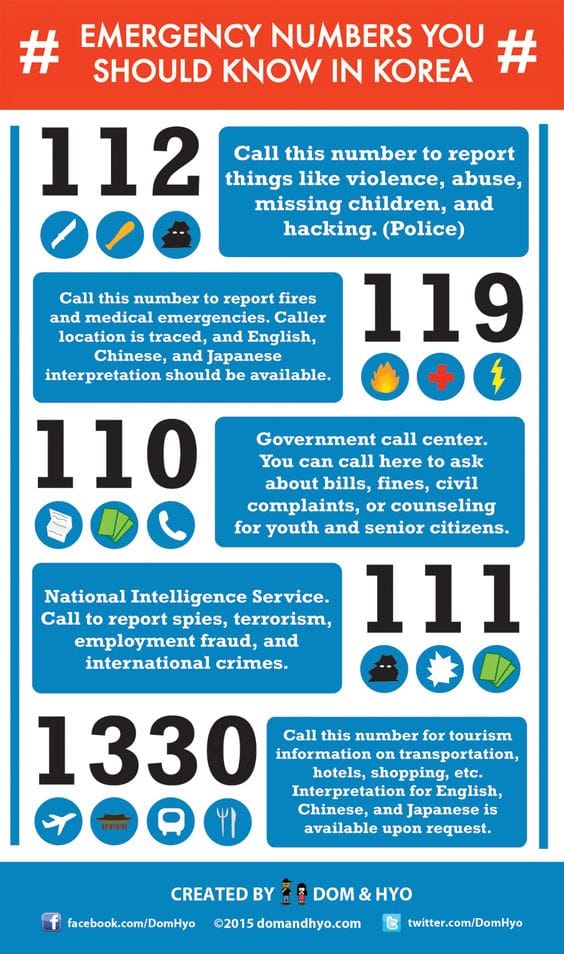 |
You should dial 112 to report violence, abuse, missing persons, and hacking, while 119 is used for medical emergencies. Your calling location is tracked and they also have English, Chinese and Japanese interpreters available.
To report terrorism, spies, employment fraud and international crimes, dial 111. For tourism information on public transport, shopping, hotels and interpretation in English, Chinese, and Japanese call 1330.
|

|
South Koreans take great pride in their food culture. That’s why it’s important to respect and be aware of the local dining etiquette. Koreans do not have their own meal but rather share a variety of main and side dishes amongst the people at the table.
Unlike other Asian cultures, Koreans do not lift their bowls off the table to eat with the bowl in their hands, but prefer to keep it on the table.
|
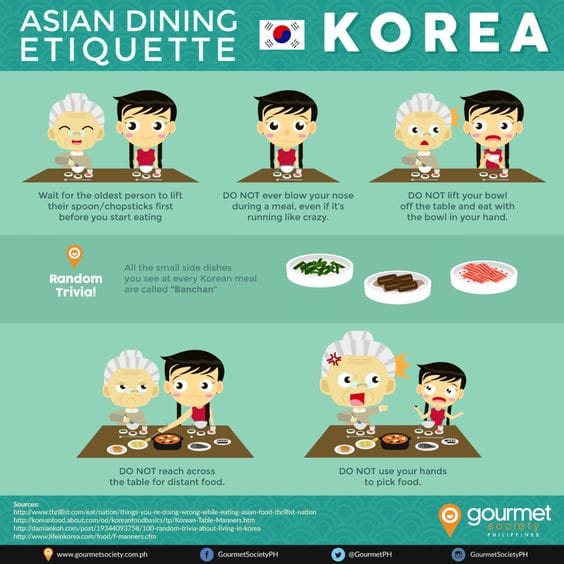 |
The many small side dishes are called banchan. Never start eating before the oldest person at the table. It is also considered rude to blow your nose during a meal.
Avoid reaching across the table for distant food by asking for someone to pass it to you. Never use your hands to pick up food.
|

|
Seoul and Busan are the two largest cities in South Korea. Seoul, the capital, is home to around 10 million people, while Busan counts a mere 3.5 million citizens.
Busan is home to Korea’s largest port and is an important economic hub. It is also a popular vacation destination due to its beaches and delicious local seafood.
|
 |
Seoul is located in the northern part of the country, whereas Busan is situated on the southeastern coast. Home to five grand palaces, government buildings and lots of temples, Seoul is the historic capital of the country.
While most teachers coming to Korea consider Seoul as their new hometown, Busan is also worth considering, as well as many other cities across the country.
|

|
South Korea is an exciting country for teaching English and living abroad, but before you make the journey over there are a few fun facts you might want to know about the country.
Around ¼ of the women in Seoul have had some form of cosmetic surgery. The two most common aesthetic procedures are the double eyelid and nose surgery.
|
 |
As no peace treaty has ever been signed, technically, North and South Korea are still at war even though the Korean War ended in 1953.
In South Korea, babies are considered 1 year old on the day they are born and everyone ages one year on January 1st. There are many more interesting facts to learn about South Korea in this infographic.
|

|
Major holidays in South Korea vary quite a bit from common holidays back home. The year starts off with Seollal celebrating the Lunar New Year.
To mark the holiday there are many parades and festivals held at temples throughout the country. Chuseok is the Korean harvest festival which is celebrated in September or October according to the lunar calendar.
|
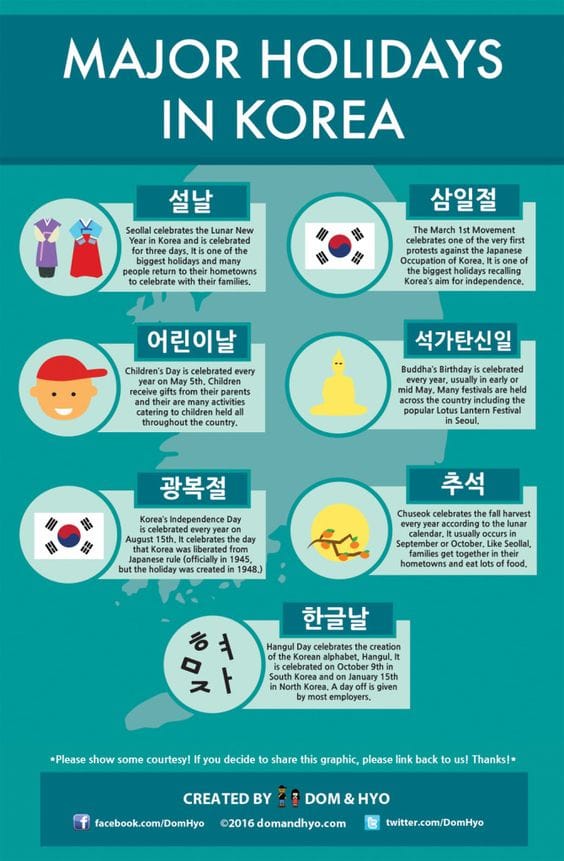 |
It lasts three days and is usually celebrated in January or February depending on the lunar calendar. One of the most important holidays of the year is Buddha’s Birthday which is celebrated in the middle of May.
Check out this list of holidays to see what other national celebrations you will get to enjoy during your stay in South Korea.
|

|
South Korea has a range of superstitious beliefs that are often unheard of in the West. For example, the number 4 is said to be bad luck.
It is important, especially for teachers, to know that writing a person’s name in red is said to bring bad luck and even death to said person.
Check out other Korean superstitions in this fun infographic.
|
 |
Just like in China and other Asian countries, you can find many elevators with the number 4 replaced with the letter F.
You should also avoid whistling at night after 10 PM as it is said to attract bad spirits or ghosts. Dreaming of pigs lately? In Korea this could mean that you will get money in the near future.
|

|
Kimchi is the number 1 side dish in Korean cuisine. If you have ever eaten at a Korean restaurant, chances are you have come across this intense taste bud adventure.
Cucumber kimchi, eggplant kimchi, and garlic chives kimchi are also very popular. There are even some sweet kimchi variations including pumpkin and sweet potato.
|
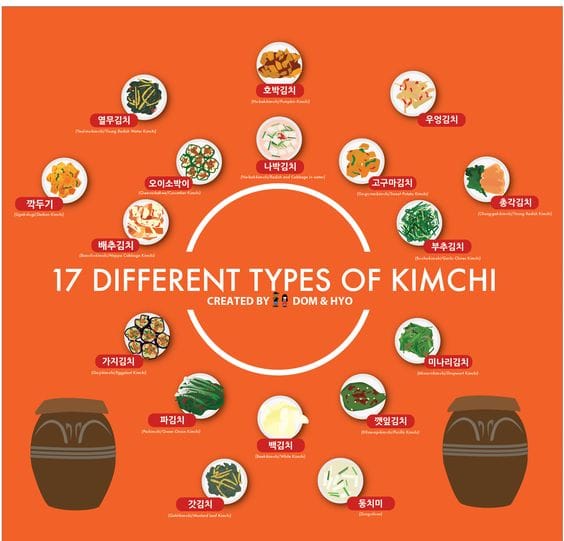 |
While the most common type of Kimchi is made of cabbage, there are numerous other varieties to try. If you can’t handle spice, you should choose white kimchi as this type is prepared without chili powder.
If you like the sound of kimchi, check out this infographic to see more popular variations of the dish.
|

|
South Korea has a fascinating culinary scene and a big part of it is made up of street food. Walk the pedestrian streets of any major city in the country and you will find a selection of popular snacks to try out.
If you have a sweet tooth try bungeobbang, a fish shaped pastry filled with red bean paste, or hotteok, a small Korean pancake with honey sauce.
|
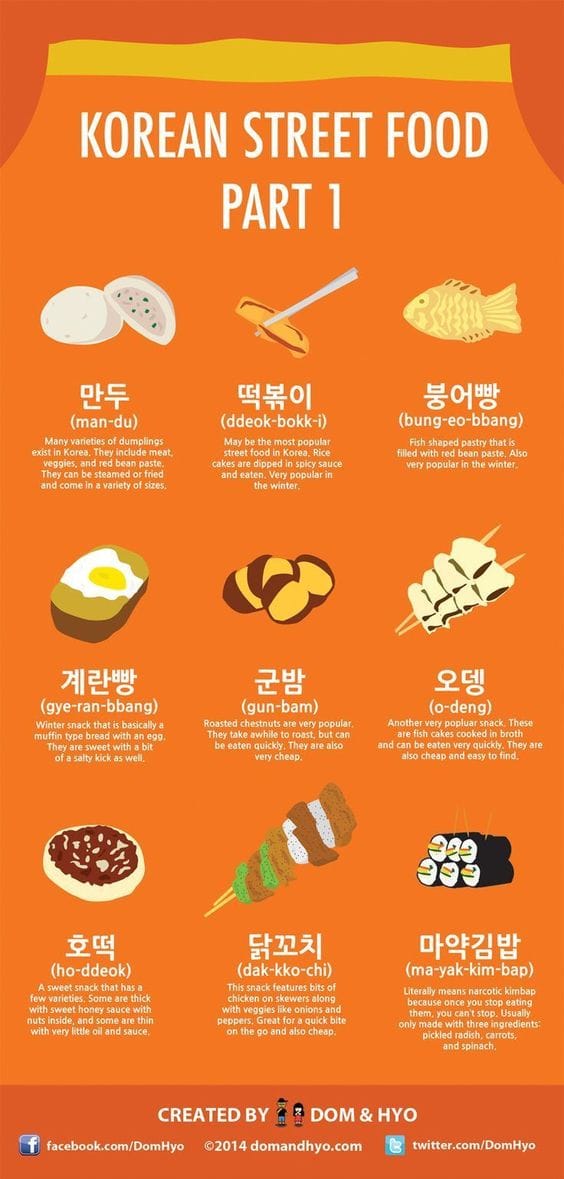 |
Mandu are Korean dumplings filled with different flavors from meat and vegetables to sweet red bean paste. Another popular snack is Korean style rice cakes in spicy chili sauce, called tteokbokki.
Whatever taste you prefer, you’ll find it in Korean street food.
|

|
The immense power of South Korea’s pop culture has brought about a series of new hand gestures in the country that can be unrecognizable to foreigners.
Squeezing your index finger and thumb creates another popular heart shape allegedly created by Kpop icon G-Dragon of Big Bang.
|
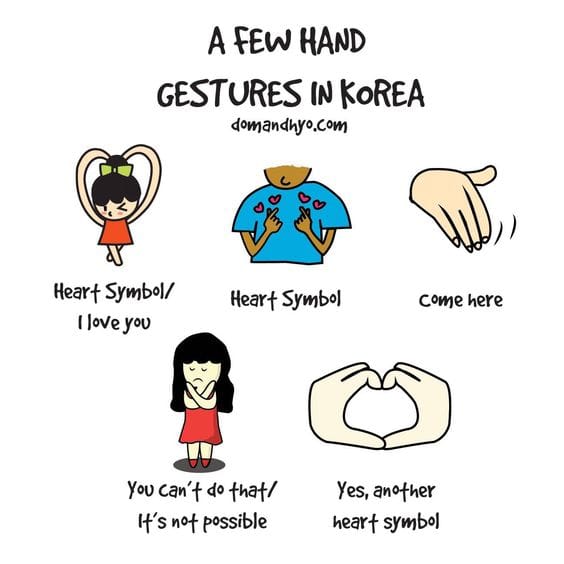 |
Often introduced by famous Korean singers and groups, they quickly catch on and are widely used by younger generations in particular. For example, using your arms over your head to shape a big heart is often used to say “I love you”.
Cross your arms like the letter X in front of your chest and you signal that something is not possible. Find out more about Korean gestures in this infographic.
|

|
South Korea is proud of its distinct cuisine. As the country is surrounded by three seas and covered in mountains, Korean dishes are often filled with seafood and mountain herbs and vegetables.
You will also find a lot of fermented preservation used in Korean cuisine. This method was used to withstand harsh winters and still plays an important role in local food today.
|
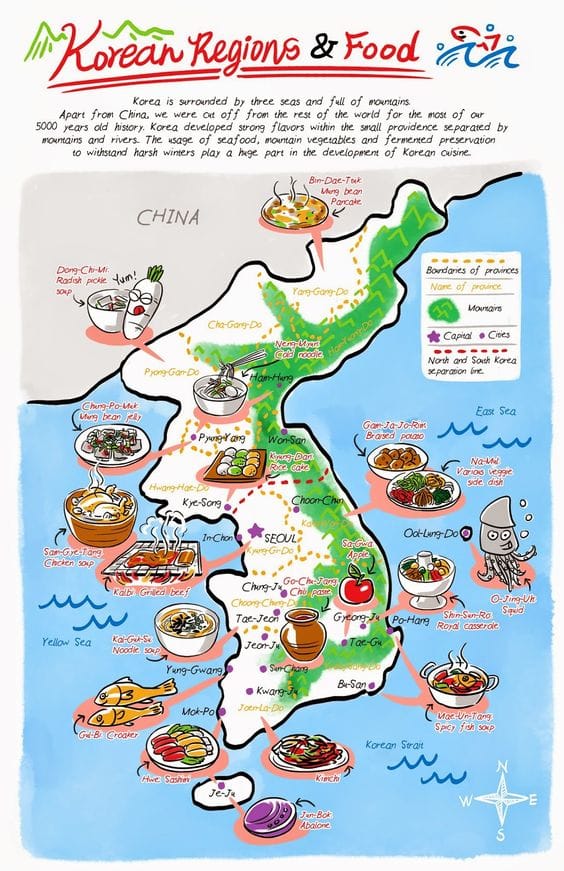 |
Added to that, Korea has been relatively isolated for much of its history which has allowed its cuisine to develop in a unique way.
Bibimbap, Kimchi and Korean BBQ are only a small taste of the large variety of food available in this relatively small country. Check out this infographic on Korea’s food by region.
|

|
The border between North and South Korea is not only a reminder of the Cold War, but it is also one of South Korea’s most interesting tourist sites.
While it is heavily guarded with soldiers from both sides, it is also the perfect location for plants and animals to thrive.
|
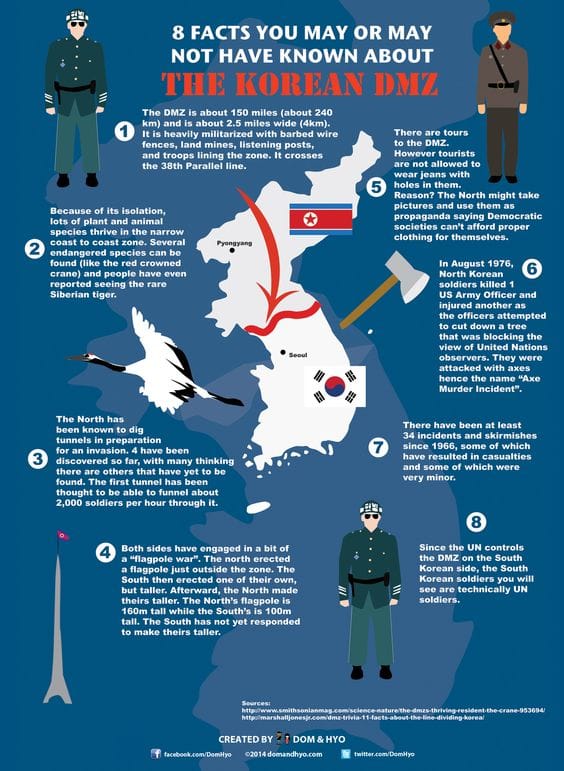 |
The Demilitarized Zone (DMZ) is around 150 miles (240 km) long and 2.5 miles (4 km) wide.
Due to its isolation, several endangered species can be found in the area, including reports of the rare Siberian tiger.
|

|
If you decide to teach English in South Korea, you might decide to learn some of the local language during your stay.
Unlike Chinese, the Korean language uses a simple alphabet that was specifically created to make it easy to learn.
Take a look at this guide on how to read Korean in 15 minutes for a fascinating introduction to the language
|
 |
While it might seem like a daunting task, learning how to read Korean is actually quite straightforward.
Because the Korean alphabet (called Hangul) was specifically created to have fewer letters that always sound the same, it is unlike many other writing systems that evolved over generations.
|

|
South Koreans love drinking alcohol and it is something that is also deeply engrained in Korean culture.
Soju is also incredibly cheap costing only $1-3 USD per bottle.
There are 10 large producers and countless smaller makers of soju in South Korea so you will find plenty of varieties to try during your stay.
|
 |
Soju is by far the most popular alcohol of choice across the country, with bottles containing anything from 16% to 45% alcohol by volume.
Foreigners who are new to the country should be aware that many points of etiquette around drinking soju have evolved over the years, such as never pour your own drink and always hold your glass with two hands when receiving a drink from another person.
|


Want to see more infographics on TESOL and TEFL? Check them out!


